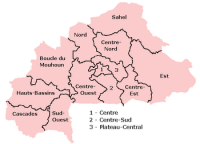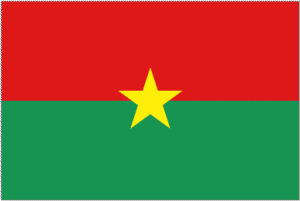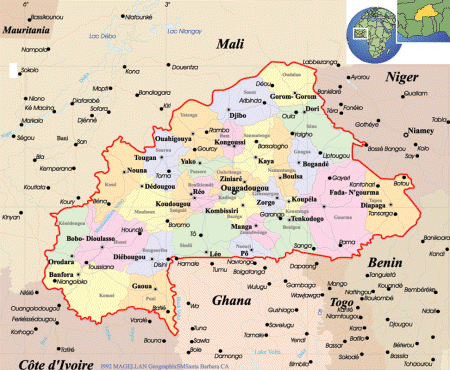BURKINA FASO
Expedition Journal
Photographs
Origins
Symbols
Regions
Languages
History
Government
Economy
Geography and Climate
Population, Ethnic Groups, Culture and Religion
Fauna and Flora
Environment
Resource Links
Lesson Plans
Check out the Route Maps
Send us an Email
Camping Information
|
Expedition |
|
Lend a Helping Hand You can help make the Virtual Classroom available to students by making a donation today. |
| World of Wonders Project: The West Africa Expedition |
|
Click on map to see it in detail |
|
| Origin of the name Burkina Faso | Official name is Burkina Faso. Burkina" may be translated, "men of integrity," from the Moré language, and "Faso" means "father's house" in Dioula. | ||||
|
Symbols
|
Click on each link below to learn more about the symbols.
|
||||
|
Regions
|
 (Click on any map to see it in detail)
|
||||
| Language | Official language is French, with recognised regional languages Mòoré, Dioula | ||||
|
History
|
History
After the fourth century present-day Mali becomes the centre of Ghana. Ghana, dominated by the Soninke or Saracolé people and centered in the area along the Malian-Mauritanian frontier, is a powerful trading state from about 700 to 1075. The Malinke Kingdom of Mali has its origins on the upper Niger River in the 11th century. Expanding rapidly in the 13th century under the leadership of Soundiata Keita, it reaches its height about 1325, when it conquers Timbuktu and Gao. Thereafter the kingdom declines and by the 15th century, it controls only a small fraction of its former domain. The Songhai Empire expands its power from its center in Gao during the period 1465-1530. At its peak under Askia Mohammad I, it encompasses the Hausa states as far as Kano (in present-day Nigeria) and much of the territory that had belonged to the Mali Empire in the west. It is destroyed by a Moroccan invasion in 1591. In the eighteenth century the area is divided in kingdoms linke the Bambara, Fulbe and Tuareg.
Compaoré, unlike his predecessor, began to attract foreign investment and expanded the private sector. In 1991 a new constitution was approved, and in the subsequent presidential election Campaoré (the only candidate) was elected. In 1992 the country held its first multiparty parliamentary elections since 1978; Compaoré's party won over two thirds of the seats amid widespread charges of fraud. The party made even bigger gains in the 1997 elections, and Campaoré was reelected in 1998. In May, 2002, the ruling Congress for Democracy and Progress (CDP) retained control of the national assembly, winning 57 seats. The president was again reelected in 2005, enormously outspending an opposition splintered among 12 candidates. |
||||
| Government |
Government
The constitution of 2 June 1991 established a semi-presidential government with a parliament which can be dissolved by the President of the Republic, who is elected for a term of seven years. In 2000, however, the constitution was amended to reduce the presidential term to five years. The amendment took effect during the 2005 elections. The amendment also would have prevented the sitting president, Blaise Compaoré, from being reelected; however, notwithstanding a challenge by other presidential candidates, the constitutional council ruled in October 2005 that because Compaoré was the sitting president in 2000, the amendment would not apply to him until the end of his second term in office. This cleared the way for his candidacy in the 2005 election. On 13 November, Compaoré was reelected in a landslide due to a divided political opposition. wikipedia |
||||
| Economy |
Economy
Burkina Faso is one of the poorest countries in the world with an average income per capita of €250 (US$300). More than 80% of the population relies on subsistence agriculture, with only a small fraction directly involved in industry and services. Low rainfall, poor soils, lack of adequate communications and other infrastructure, a low literacy rate, and a stagnant economy are all longstanding problems. The export economy also remains subject to fluctuations in world prices.
Unemployment causes a high rate of emigration. For example, three million citizens of Burkina Faso live in Côte d'Ivoire. According to the Central Bank of West African States, these migrants send substantial amounts of money back to Burkina Faso each year. Since the 1967 expulsions from Ghana, this situation has provoked tensions in the recipient countries. The most recent crisis occurred owing to the events of 2003 in Côte d'Ivoire, which led to the return of 300,000 migrants. The monetary unit is the CFA franc, consisting of 100 centimes (500 francs equal U.S.$1; 2008 average. WEIGHTS AND MEASURES: Metric weights and measures are used. |
||||
| Geography and Climate |
Geography
Burkina Faso is a landlocked Sahel country that shares borders with six nations. It lies between the Sahara Desert and the Gulf of Guinea, south of the loop of the Niger River. The land is green in the south, with forests and fruit trees, and desert in the north. Most of central Burkina Faso lies on a savanna plateau, 198-305 meters (650-1,000 ft.) above sea level, with fields, brush, and scattered trees. Burkina Faso's game preserves--the most important of which are Arly, Nazinga, and W National Park--contain lions, elephants, hippopotamus, monkeys, warthogs, and antelopes. Tourism is not well developed. There are no areas in Burkina Faso on the World Heritage List.
wikipedia |
||||
|
Population
Culture and Religion |
Population
Burkina Faso's 15.3 million people belong to two major West African cultural groups—the Voltaic and the Mande (whose common language is Dioula). The Voltaic Mossi make up about one-half of the population. The Mossi claim descent from warriors who migrated to present-day Burkina Faso from Ghana and established an empire that lasted more than 800 years. Predominantly farmers, the Mossi kingdom is still led by the Mogho Naba, whose court is in Ouagadougou.
While exact statistics on religion in Burkina Faso are not available and vary widely, the Government of Burkina Faso estimated in its most recent census (1996) that approximately 60 percent of the population practice Islam, and that the majority of this group belong to the Sunni branch, while remaining minorities adhere to the Shi'a branch, and significant numbers of Sunni Muslims identify with the Tijaniyah Sufi, or Salafi traditions. The Government also estimated that 24 percent of the population maintains traditional indigenous beliefs, 17 percent practices Roman Catholicism, and 3 percent are members of various Protestant denominations.
Literature in Burkina Faso is based on the oral tradition, which remains important. In 1934, during French occupation, Dim-Dolobsom Ouedraogo published his Maximes, pensées et devinettes mossi (Maximes, Thoughts and Riddles of the Mossi), a record of the oral history of the Mossi people. The oral tradition continued to have an influence on Burkinabè writers in the post-independence Burkina Faso of the 1960s, such as Nazi Boni and Roger Nikiema. The 1960s saw a growth in the number of playwrights being published. Since the 1970s, literature has developed in Burkina Faso with many more writers being published.
wikipedia |
||||
| Fauna and Flora |
Fauna and Flora The area is largely wild bush country with a mixture of grass and small trees in varying proportions. The savanna region is mainly grassland in the rainy season and semidesert during the harmattan period. Fauna, possibly the widest variety in West Africa, includes the elephant, hippopotamus, buffalo, monkey, crocodile, giraffe, various types of antelope, and a vast variety of bird and insect life. The are four National parks. Encyclopedia of the Nations |
||||
| Environment |
Environment Millions of trees are planted every year to reverse desertification. However the growing socio-economic needs of local populations pose a constant threat to these efforts. The major environmental problems facing Burkina Faso are recurrent drought and the advance of the northern desert into the savanna. This trend toward desertification has been increased by overgrazing of pasture, slash-and-burn agriculture, and overcutting of wood for fuel. Almost all the trees within 40 km (25 mi) of the capital have been felled. The frequency of droughts in Burkina Faso and its location in the Sahara desert contribute to the nation's water supply problems. The country has 17.5 cu km of renewable water resources, but only 66% percent of the city population and 37% of rural dwellers have access to safe water. According to the World Health Organization, about 80% of all disease in Burkina Faso is caused by unsafe water. Pollution problems result from uncontrolled disposal of sewage and industrial wastes. The Ministry of Environment and Tourism is the principal government agency concerned with the environment. Burkina Faso has 12 national parks and wildlife reserves totaling 2,855,000 hectares. Altogether, 10.4% of its total land area is protected. The country has three Wetlands of International Importance. Of 147 species of mammals, 6 are considered endangered, including the African hunting dog, the chimpanzee, and the African elephant. The Sahara oryx, or white oryx, has become extinct in the wild. One bird species in a total of 335 and one reptile are also threatened. Encyclopedia of the Nations |
||||
|
We thank our West Africa Expedition Sponsors Please visit their websites
|
|
Contact us for information regarding sponsorship opportunities.
Join the Virtual Classroom. Complete the free registration form for your classroom today. Support the expeditions. Your donation will help to continue the research, documentation and Virtual Classroom web site presentation of these wonderful cultures and experiences to the broadest possible audience. To find out how you can help, please follow this link to our Helping Hand page. Thank you, now it's time to explore!
|





